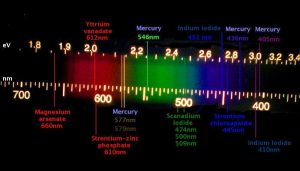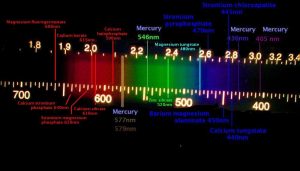It is little secret that the spectral quality of various lamps has been a debating point among us in the reef-keeping hobby. Quantification of lamp output quality is, at best, an expensive proposition. However, qualification of spectra is so inexpensive that even the budget-conscious hobbyist can afford a ‘spectrometer’ (these are marketed under the name ‘spectrometer’ and since they have a graduated scale, the term is technically correct). There are several ‘instruments’ available for just a few dollars from various suppliers. Even better, they are extremely simple to use and can provide valuable information to hobbyists.
These devices will allow quick estimates of light quality. The possibilities are limited only by your imagination. We’ll discuss a few of these at the close of this article.
I have two ‘spectrometers’ from two sources – my favorite is a unit purchased from the Astronomical Society of the Pacific for a paltry $29.95 (plus shipping, taxes, etc.). It has features that the less expensive ($6.95) spectrometer from Edmund Scientific does not. Both are made of plastic and house a diffraction grating for spectral separations. Each is marked with a scale. That is pretty much where similarities end.
Available Instruments
Reef hobbyists usually have collected a substantial amount of equipment after being in the hobby for a few years. Some devices have found their way to the ‘bone yard’ while others are of great use. Although the spectrometers discussed in this article are inexpensive, I can save anyone a little time, aggravation and perhaps a few bucks if you’re in the market for an item such as this. The suggested suppliers are of course not the only sources, but I have had dealings with both and have found them to provide prompt reliable services.
Spectrum Card
Spectrum Card, Night Spectra Quest. A small diffraction grating is sandwiched between two credit card-size pieces of cardboard and allows a glimpse of spectral characteristics.
Edmund Scientific (http://scientificsonline.com/) offers this device as part #3053066 for $4.95. A small instruction booklet is included and its contents seem geared toward grade-schoolers. Five dollars isn’t much money at all, but I felt annoyed that I had spent this much plus shipping on something as useless as this. I do not recommend it for ‘aquaria’ purposes.
Classroom Spectrometer
This item is also available from Edmund Scientific and is far superior to their Spectrum Card (see above). The spectrometer body is made from sturdy plastic and uses a diffraction grating to split light into its various spectral components. The spectrum falls upon a graduated scale (400-700nm only), which is viewed through a small aperture. The unit’s compactness is also its greatest drawback. The scale is not adjustable as those of a pricier model, and the small display is sometimes difficult to read. Edmund advertises an accuracy of ~50nm. This is fine for demonstrating the concepts of spectra and diffraction gratings and is a value at only $6.95 (plus shipping and other nominal costs). If your funds are extremely limited, and you’re looking for something to ‘guesstimate’ spectral quality then this item is for you. Stock number is 3082305.
Project STAR Spectrometer
The Spectrometer from Project Star is my personal preference of all the spectrometers in its class, and it is also the most expensive at $29.95 plus shipping (~4X the price of its competitor – the ‘Classroom spectrometer’ – above). Its superior features make it worthy of consideration. It is relatively large and this allows for easy handling and viewing. The internal scale is easy to read and features scales for wavelength (in nanometers) and energy (in electron volts). The scale is engineered to allow for calibration against the mercury discharge (546nm) of almost any fluorescent lamp – it is easy to do (this is a real plus if the instrument gets dropped or bounced around). The calibration feature is not available on the other spectrometers I have seen and tested. The plastic body is not particularly robust and could be crushed fairly easily. The sections of the housing are held together with brass brads, so it will not easily pop apart.
A lot engineering went into this inexpensive, handheld device (mine says it was developed by the Harvard-Smithsonian Center for Astrophysics). It is available from the Astronomical Society of the Pacific (www.astrosociety.org, and follow the link to the ‘AstroShop’). The part number is OA160. Edmund also offers this spectrometer, but at a higher price of $34.95 plus nominal fees.

Figure 1. Spectral signature of a CoralVue 250-watt 20,000K metal halide lamp. Overall, the lamp appears crisp blue- white (judged by the scales’ coloration).
The graduated scale is from 350nm to 750nm, but it will not allow a visual recognition of near-infrared or ultraviolet energy – it will allow you to see only those wavelengths which your eyes normally perceive. However, some persons have an ability to ‘see’ into the UV range (my aging eyes can see a bandwidth of about 410nm (violet) to ‘red’ at ~660nm).
As with all equipment – read and follow safety precautions – do not look directly at the sun, any source of ultraviolet energy or extremely bright light source! Instead use a reflective white surface and ‘bounce’ the light into the spec.
I highly recommend this device if you’re looking for an easy and inexpensive way to estimate spectral qualities.

Figure 2. Spectral signature of an Iwasaki 400-watt 6,500K metal halide lamp – a true full spectrum lamp. Compare its spectral quality to that of sunlight (Figures 4 and 5).
Keep Records!
I have an opinion and I’ll state it here – good record-keeping should always be practiced! This starts when lamps are replaced (mark your calendar when replacing metal halide lamps, while actually marking fluorescent lamps’ replacement date with an indelible marker). It’s not a bad idea to photograph spectra of new lamps and then every six months (or more often if your schedule allows) in order to estimate spectral degradation. I prefer the use of a digital camera since older film technology leaves too much leeway with the developer.

Figure 3. Spectral signature of an inexpensive fluorescent desk lamp. Compare the scale’s yellow-orange tint to the ‘whiteness’ of those in Figures 2 and 3. Figure 6 identifies line spectra of various fluorescent compounds – can you determine which this lamp contains?
Photographing spectral displays of the Project STAR spectrometer is very easy, provided your camera has a macro mode. The photos accompanying this article were taken with an Olympus C-5050 (5-megapixel) in the macro mode. Post processing cropped the photographs and contrast plus brightness were moderately adjusted – but these are representative of this spectrometer’s display (see Figures 1-3).
Interpreting the Results
Lamps used for aquaria lighting will lose output over a period of time and spectral qualities will shift. This degraded performance could be due to various factors, including ‘sputtering’ of electrodes (coating the inside of the tube with metal), loss of halides, etc. Figure 4 shows a few of the spectral spikes and the responsible elements and compounds commonly seen in metal halide lamps. Figure 5 does the same for fluorescent lamps.

Figure 4. Emission spectra of various compounds often found in metal halide lamps.The spectrum is that of natural sunlight.
Potential Uses – Use Your Imagination!
The Project Star spectrometer will enable one to examine many different parameters. The obvious determination is that of initial lamp spectral quality, followed by degradation of spectral output over a period of time. What effects will that new skimmer or activated carbon have on transmitted light quality – especially in deeper aquaria (use a white reflective
surface placed within the aquarium at a 45ºangle). What is the peak fluorescence of that nice Acropora you just brought? Will that fluorescent color shift under your lighting system – If so, to what wavelength? Simple observations of lamp spectral quality and shifts in coral fluorescence could help unlock some of the remaining mysteries of anthozoan pigmentation. That’s the beauty of these inexpensive devices (especially the spectrometer from Project Star) – they can deliver quality information at prices practically unknown in the reef-keeping hobby.
Reference
- Kaufman, J. (ed.), 1984. IES Lighting Handbook. Illuminating Engineering Society of North America. New York.





0 Comments